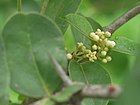Note: This is a project under development. The articles on this wiki are just being initiated and broadly incomplete. You can Help creating new pages.
Gymnema sylvestre - Meṣaśṛṅgī
Meṣaśṛṅgī consists of dried leaf of Gymnema sylvestre. It is a large woody, much branched, climber, with pubescent young parts, found throughout India in dry forests upto 600 m.
Contents
[hide]- 1 Uses
- 2 Parts Used
- 3 Chemical Composition
- 4 Common names
- 5 Properties
- 6 Habit
- 7 Identification
- 8 List of Ayurvedic medicine in which the herb is used
- 9 Where to get the saplings
- 10 Mode of Propagation
- 11 How to plant/cultivate
- 12 Commonly seen growing in areas
- 13 Photo Gallery
- 14 References
- 15 External Links
Uses
Lower Blood Sugar, Cholesterol, Heart Disease, Weight Loss, Diabetes, Weight loss, Eye diseases, Eye diseases, Allergies, Constipation, Cough, Dental caries, Obesity, Stomach ailments, Viral infections.
Parts Used
Chemical Composition
Triterpenoid saponins of gymnemic acid A, B, C and D with sugarresidues such as glucuronic acid, galacturonic acid, ferulic and angelic acids attached as carboxylic acids. [1]
Common names
| Language | Common name |
|---|---|
| Kannada | Kadhasige |
| Hindi | Gudmaar, Medhaa Singee |
| Malayalam | Cakkarakkolli, Madhunaashini |
| Tamil | Shirukurum Kaay, Shakkaraikkolli |
| Telugu | Podapatro |
| Marathi | NA |
| Gujarathi | NA |
| Punjabi | NA |
| Kashmiri | NA |
| Sanskrit | Madhunāśinī, Ajāśṛ¤ṅgī |
| English | Periploca of the wood |
Properties
Reference: Dravya - Substance, Rasa - Taste, Guna - Qualities, Veerya - Potency, Vipaka - Post-digesion effect, Karma - Pharmacological activity, Prabhava - Therepeutics.
Dravya
Rasa
Tikta, Kaṣāya
Guna
Laghu, Rūkṣa
Veerya
Uṣṇa
Vipaka
Kaṭu
Karma
Vātahara, Kaphahara, Viḍaghna, Dīpana
Prabhava
Habit
Identification
Leaf
| Kind | Shape | Feature |
|---|---|---|
| Paripinnate | Oblong | Leaf Arrangementis Alternate-spiral |
Flower
| Type | Size | Color and composition | Stamen | More information |
|---|---|---|---|---|
| Unisexual | 2-4cm long | Pink | Flowering throughout the year and In terminal and/or axillary pseudoracemes |
Fruit
| Type | Size | Mass | Appearance | Seeds | More information |
|---|---|---|---|---|---|
| Oblong pod | Thinly septate, pilose, wrinkled | Seeds upto 5 | Fruiting throughout the year |
Other features
List of Ayurvedic medicine in which the herb is used
Where to get the saplings
Mode of Propagation
How to plant/cultivate
Commonly seen growing in areas
Tropical area, Subtropical area.
Photo Gallery
References
External Links
- Ayurvedic Herbs known to be helpful to treat Lower Blood Sugar
- Ayurvedic Herbs known to be helpful to treat Cholesterol
- Ayurvedic Herbs known to be helpful to treat Heart Disease
- Ayurvedic Herbs known to be helpful to treat Weight Loss
- Ayurvedic Herbs known to be helpful to treat Diabetes
- Ayurvedic Herbs known to be helpful to treat Weight loss
- Ayurvedic Herbs known to be helpful to treat Eye diseases
- Ayurvedic Herbs known to be helpful to treat Allergies
- Ayurvedic Herbs known to be helpful to treat Constipation
- Ayurvedic Herbs known to be helpful to treat Cough
- Ayurvedic Herbs known to be helpful to treat Dental caries
- Ayurvedic Herbs known to be helpful to treat Obesity
- Ayurvedic Herbs known to be helpful to treat Stomach ailments
- Ayurvedic Herbs known to be helpful to treat Viral infections
- Herbs with Leaves used in medicine
- Herbs with common name in Kannada
- Herbs with common name in Hindi
- Herbs with common name in Malayalam
- Herbs with common name in Tamil
- Herbs with common name in Telugu
- Herbs with common name in Sanskrit
- Herbs with common name in English
- Habit - Herb
- Index of Plants which can be propagated by Seeds
- Herbs that are commonly seen in the region of Tropical area
- Herbs that are commonly seen in the region of Subtropical area
- Herbs
- Repeat plant



